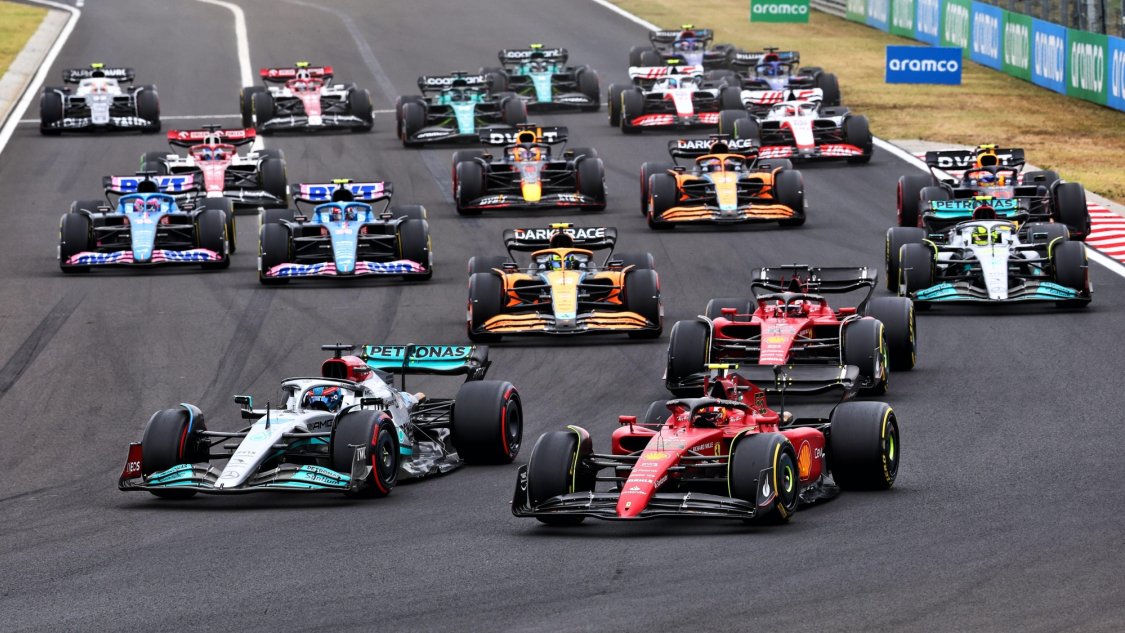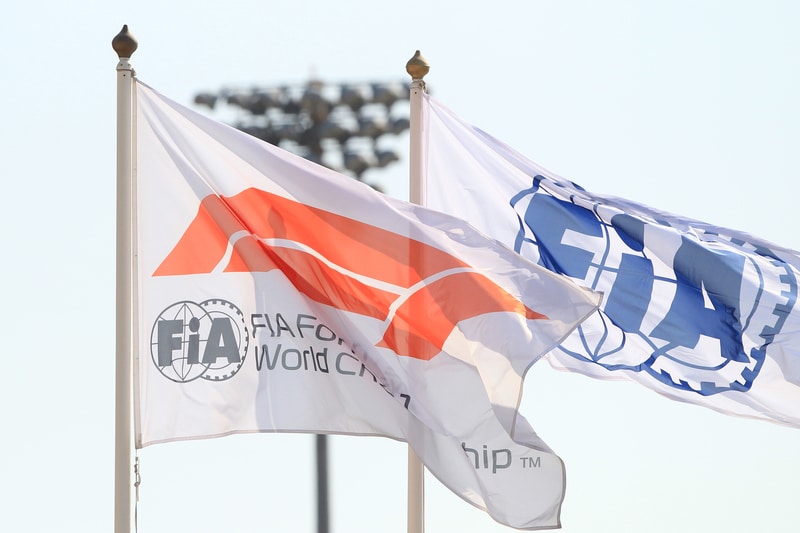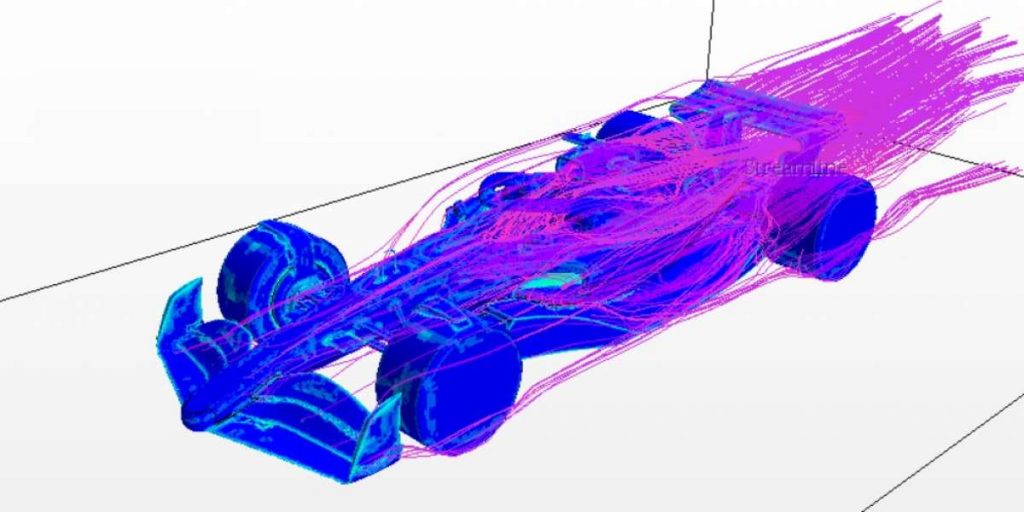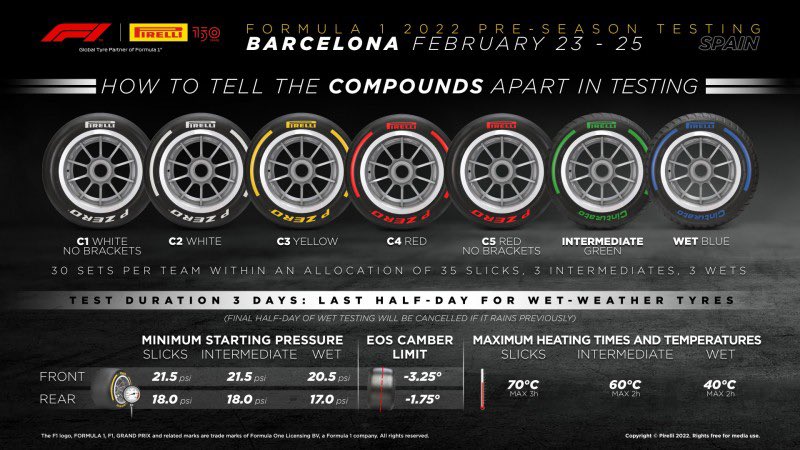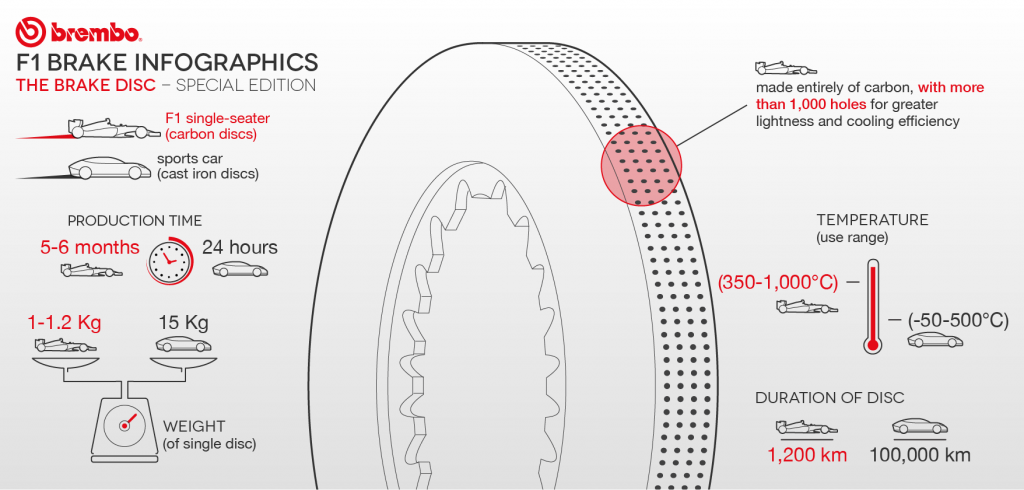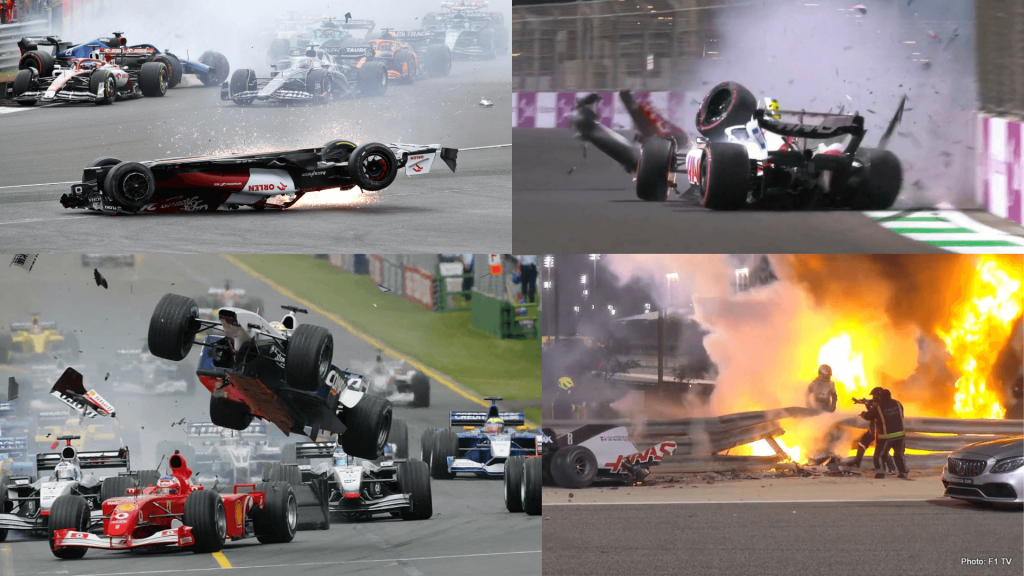What is Formula 1?
Formula 1 also known as F1 is a motorsports league that is widely accepted as the highest class of racing of open-wheeled-single-seat racing cars. This sport is governed by the Fédération Internationale de l’Automobile (FIA). All the regulations and rights to host this high-performance motorsport league are sanctioned by the FIA.
The world’s driving championship which was started in 1950 lately became the FIA Formula 1 world championship in 1981. The name “Formula” referred to a set of rules adhered to by all the participants and competitors in this sports league. A single season of Formula 1 consists of several races known as “Grand Prix” which are held in different countries around the world. A race takes place in specially designed and built circuits and closed streets that are not a circle. Currently, there are 20 world-class drivers and 10 constructor teams competing with each other for both the Formula 1 drivers’ championship and the Formula 1 constructors’ championship.
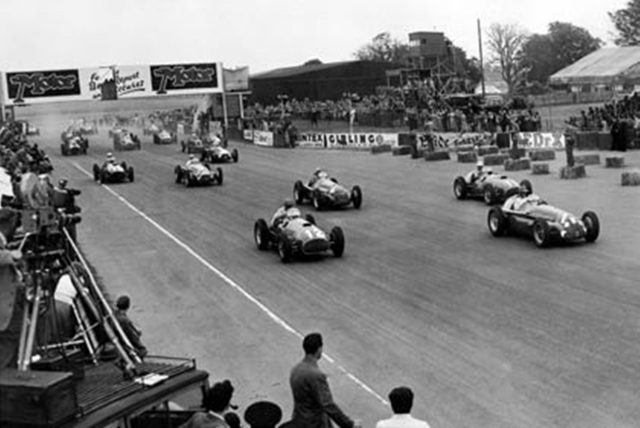
Is Formula 1 a sport? A real sport?
According to the Oxford dictionary, sport is an activity involving physical exertion and skill in which an individual or team competes against another or others for entertainment. Does Formula 1 get tally with this definition? Definitely yes, driving needs a set of skills and it is an activity that is physically demanding. Therefore, according to the definition, Formula 1 is a sport. But within society, constant debates are going on about whether F1 is a real sport or not. Even most other sports fans do not tend to consider F1 drivers as real athletes. But in reality, these F1 drivers are some kind of high-performance athletes who are dealing with very high speeds and G-forces which are a few times higher than the normal gravitational forces. A driver can lose up to 5 kilos of his/her body weight during a single race. So, it is not that fair enough not to consider F1 drivers as real athletes. And most importantly Formula 1 is also a very lavish, posh, and expensive form of entertainment.
What’s the big deal?
It’s about money.
Formula 1 is one of the most expensive sports that exist on the planet. And money is like the bloodline of the sport. Money is a huge factor for a car and a team to chase wins. The total cost of hosting a complete F1 season costs almost $4 billion – $5 billion. Each single constructor team is allowed to spend under $146 million throughout the season. And the cost of a single F1 car is labeled at an insane $15 million price tag. Some of the parts of the car are valued at millions of dollars. As an example, the F1 car is mainly made out of extremely rigid, strong, and lightweight materials such as carbon fiber, Aluminum, titanium, etc. The external structure which is made out of carbon fiber costs $600000 – $750000.
Competing in F1 is not an easy and cheap task. And staying ahead of other competitors costs a lot too with all the development and engineering aspects. And F1 is a pretty popular sport with millions of people watching and enjoying the race. The TV viewership of a single-race weekend clocked at an average of 100 million. The cumulative TV audience for 2021 was 1.55bn, up 4% from the 2020 season. So, an average of 1.5bn to 2bn watches F1 from their TVs.
And annually there is a user engagement of nearly 2bn across all the social media platforms out there. Therefore, F1 is more like a perfect marketing platform for industries and businesses. There are sponsorships and ownerships worth billions of dollars in this sport. Automobile manufacturers like Volkswagen, Mercedes Benz, and Aston Martin are investing piles of money just to make themselves noticed in this automobile game and the so-called pinnacle of motorsport.
Engineering at its finest.
F1 cars are the fastest cars exist in the world. This F1 car is a marvel of mechanical and automobile engineering itself. Each car weighs only 750kg housing a 1000hp engine. Those engines are really powerful and powered by V6 hybrid technology. This F1 car can obtain an insane top speed of 370kmh-1(230mph). And they run with an extremely complex aerodynamic setup. In designing and manufacturing a race-winning car, there should be a perfect synchronization of high downforce and less drag. An airplane is the complete opposite of an F1 car. An airplane uses its aerodynamic features such as fins and ailerons to lift itself from the ground. But an F1 car uses its aerodynamic features such as a spoiler and front wings to stick the car into the ground.
- Power Unit & Gearbox
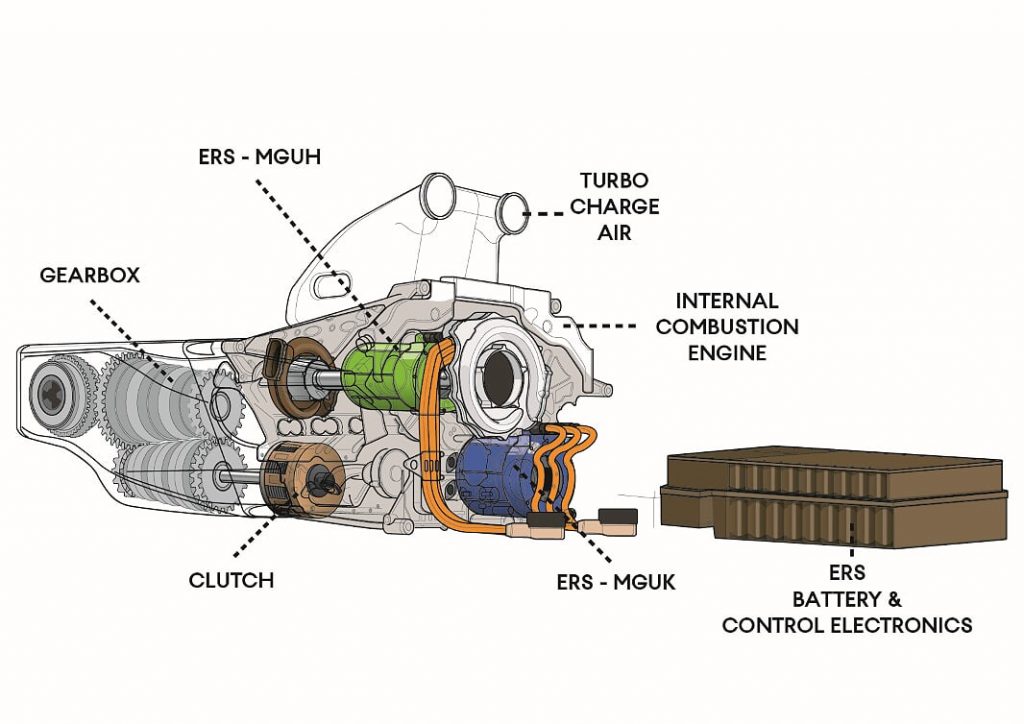
An engine can be used only in 5 races, which means one engine can be used only for a distance of 1500km. The current generation of F1 engines, they are powered by V6 hybrid technology. This means each engine consists of six cylinders, constructed in a V-configuration at 90 degrees, with a 1.6-liter displacement. And two electric machines that recuperate and deliver energy make up the hybrid F1 engine of today. The Motor Generator Unit-Heat (MGU-H), which is attached to the turbocharger and captures extra energy from the exhaust, and the Motor Generator Unit-Kinetic (MGU-K), which captures kinetic energy when the car is braking, are two examples. Both motor generator units transform the energy from their respective fuel sources into electrical energy, which is then used to move the vehicle forward. In previous generations, F1 cars were powered by V8 and V12 engines as well. But those mighty engines were dumped because of the high level of CO2 emissions and higher fuel mileages. FIA and F1 are planning to go carbon neutral by 2030, therefore manufacturers had to adapt to hybrid technology which is more eco-friendly. But this adaption has not affected the performance of those mighty machines.
Currently, these engines are running with nearly 1000 horses inside which is insane when we compare to the 150 horses in the high-end road car engines. With these 1000hp engines, F1 cars are capable of marking nearly 360kmh-1 on straight tracks and 200kmh-1 to 300kmh-1 speeds in corners as well. And these F1 cars have 7 or 8-speed gear gearboxes which are very well-functional in very harsh environments. In normal road cars, they can’t change shifts within a very small amount of time. If someone changes shift within a very short period, it will hurt the components of these road cars a lot. But F1 drivers are changing the shifts very occasionally. They normally change the gears 60-70 times in a single lap of 5km or 6 km. Therefore, manufacturers should design and manufacture very rigid gearboxes and components.
- Aerodynamics
F1 cars are contained extremely complex aerodynamic setups and features that help those highspeed vehicles to travel faster in corners without losing their grip. And these aerodynamic features are capable of letting an F1 car can be driven upside down in a tunnel with the extremely high downforces these cars have. These aerodynamic features aim to lessen drag while enhancing downforce. Higher cornering speeds and shorter braking distances are also made possible by this. 80% of the grip needed for the car is produced by the downforce created by these aerodynamic features.
F1 vehicles’ aerodynamic designs, which enable fast cornering speeds, are principally responsible for their ability to resist centrifugal forces of up to 4G (4x Gravitational force) without skidding off the track. Without downforce, this would not be possible, ensuring both performance and safety. By speeding the air passing over the wings, which results in an area of low pressure above the wing and an area of slower moving, higher pressure air beneath the wing, aircraft use their wings to generate lift, which is then used to lift them off the ground.
The upward force of lift is produced by this pressure imbalance, enabling the plane to take off. This idea is applied reversed in F1, where designers flip an airplane wing to accelerate the air underneath it, resulting in a region of lower pressure underneath the wing, which produces downforce. Almost all the individual components of an F1 car host extreme aerodynamic effects on the car. From the front wing and floor area to the rear spoiler and rear diffuser, all of them should be designed and engineered properly to complete a race-winning car.
- Tires
An F1 car is sitting on 4 specially designed tires. A single tire is 660 mm-720 mm in diameter in diameter. Front tires have a width of 305 mm while 405 mm for rear tires. And there are different types of tires as well, such as hard, medium, soft, intermediate, and wet. And those types of tires can be identified by the colored rim on the tires white for hard, yellow for medium, red for soft, green for intermediate, and blue for wet tires. Drivers and teams are provided with a limited number of sets of tires for a race weekend. And those teams and drivers are free to choose any type of tire concerning their racing strategies and racing conditions. These different types of tires have different sets of characteristics as well which is crucial for track conditions and racing strategies.
Soft tires – These represent the fastest rubber but are likely to wear out really quickly before the harder compounds do which means they have the highest grip. (10 – 15 laps)
Medium tires – This is usually slower than the soft but faster than the hard. And they last longer than the soft, but not as long as the hard tires. (20 – 30 laps)
Hard tires – Have the least grip but are supposed to remain in working order the longest. And obviously the slowest. (25 – 35 laps)
Intermediate tires – These tires are mostly used in moderately wet track conditions. They have a lesser grip than hard tires. But in wet conditions, they have a prominently higher grip than hard or soft tires. (15 – 25 laps)
Wet tires – These tires are supposed to use in extremely wet conditions. And these tires can evacuate 85 liters of water per second per tire in 300kmh-1 (25 – 30 laps)
And these sets of tires can be used in a very limited number of laps or distances, which means they have to change the tires during a race a few times. Every team has a specially trained crew named the pit crew to change those tires during a race. They are capable of changing the set of tires under a mind-blowing 3 seconds. These tires are degrading with the influence of the track conditions and temperature. And these factors are critical when a driver maintains his higher speeds and higher grip. Higher tire temperatures are always appreciated for a higher grip on the tracks.
- Braking system
F1 cars have the most advanced braking system among all land vehicles. To play around with lightning speeds around the track, there should be a strong braking system. Any driver would agree with this. And the braking stability is a personal factor to consider for any F1 driver. They are allowed to set up and adjust their braking systems even during an as they prefer which enables them to have better drivability. The brakes and the braking system are crucial for these high speeds. The driver will apply the brake for just 2.09 seconds, decreasing the vehicle from 210 mph to 83 mph in just 122 meters, or around 20 car lengths!
More than just the brakes are needed for this astounding achievement; it also needs the wide Pirelli slick tires for grip, as well as enormous quantities of downforce, strong leg muscles, and rapid reactions from the driver as well. There is a carbon-fiber made brake pedal in the driver’s cockpit. Two master brake cylinders, one for the front wheels and one for the back, are compressed when the driver pushes the brake pedal, creating fluid pressure toward all four tires. And these braking systems are super light. They weigh only 1.5 Kg to 2 Kg. A normal car consists of a braking system of almost 15 Kg. And these brake discs and other components of the braking system of an F1 car can reach up to 1000°C during braking. These specific peak temperatures are not a problem for the carbon discs; but, sustained high temperatures can lead to various problems. The majority of cooling occurs on straightaways, where the automobile is moving quickly and allows for a lot of air to flow through the brake ducts. And the braking system is important to the power unit as well. With the hybrid-powered engine, the braking system helps to harvest energy while braking.
These high-performance braking systems are designed and produced by specially trained professionals at official F1 braking component suppliers at Brembo.
- Safety
An F1 car can be undoubtedly considered one of the safest land vehicles that exist. There can be a number of deadly crashes and accidents in a single race. Even though these crashes and accidents are dangerous and deadly these mighty machines are capable of protecting the driver at all costs. Considering the nature of the sport, F1 cars are surprisingly safe. All the factors such as high speeds, track conditions, and open cockpit design make this sport more and more dangerous and deadly. The governing body of the sport, FIA is constantly reevaluating its safety regulations in order to improve the safety of drivers. There are numerous safety features available in an F1 car. The quality and reliability of these features are regulated and checked by FIA. There are features such as the padded driver cell, the halo, wheel tethers, a crash protection structure, and a fire suppression system that ensure the safety of drivers.
None of these features can ensure the driver’s life 100% in fatal crashes and accidents, but these features have succeeded in the task to protect the driver as much as they can. In F1 crashes are happening with forces of 40G to 70G. The highest reported G force of an accident is 254G (254 times of gravitational force). Unfortunately, the driver who experienced this massive accident died in that accident. But drivers could walk away safely in accidents with 50G or 60G forces which is incredible. Even though this adrenaline-pumping sport gives us great pleasure and satisfaction, this is more like an extreme sport with extreme dangers and life-threatening scenarios.
- Racing strategy
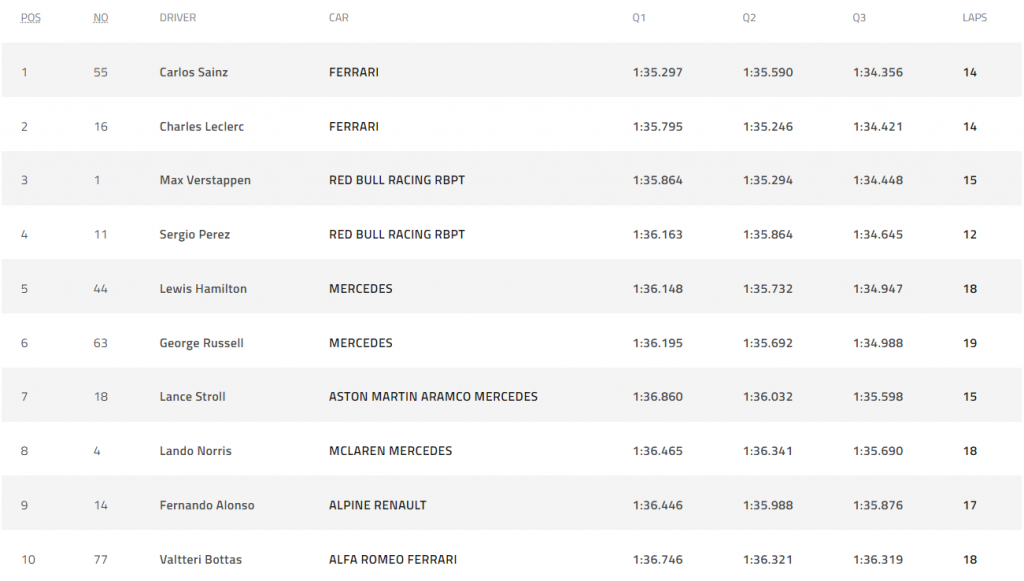
Strategy is like the key to winning a race. To win a race there are a lot of overtakes and pitstops happening during a race. And these stops and overtakes are made possible by the race strategy. Due to the very fast phase of this sport, winning an F1 race is not a simple task. And those wins are determined by a few thousand of a second. In order to preserve that very tiny chunk of time, the drivers and the teams are considering the smallest details possible to make their win happen. They do consider factors like tire temperatures, track temperature, and conditions, climate, wind speed, fuel limits, the weight of the car, aerodynamic setups, opponent car details, opponent race paces, and rules & regulations as well. There is a team called race strategists who are working with millions of data and scenarios to deliver the best strategy and game plan to win a race to their team and drivers.
Every team and driver has allocated race strategists with their teams. They are working with these massive amounts of data before the race, during the race, and after the race as well. They use a number of specially designed and dedicated computer software and data analysis tools to determine the best strategies. The strategy team continuously monitors the speed and positioning of the other cars while performing live simulations on the pit wall, in the garage, and even back at base to foresee how the strategy options will change. A bad strategy will definitely make the best car and the driver lose the race even though they have the best chances to win the race. And with a decent car and a decent driver but with a good strategy will make that team win in races.
- Drivers (Athletes / Extreme athletes)
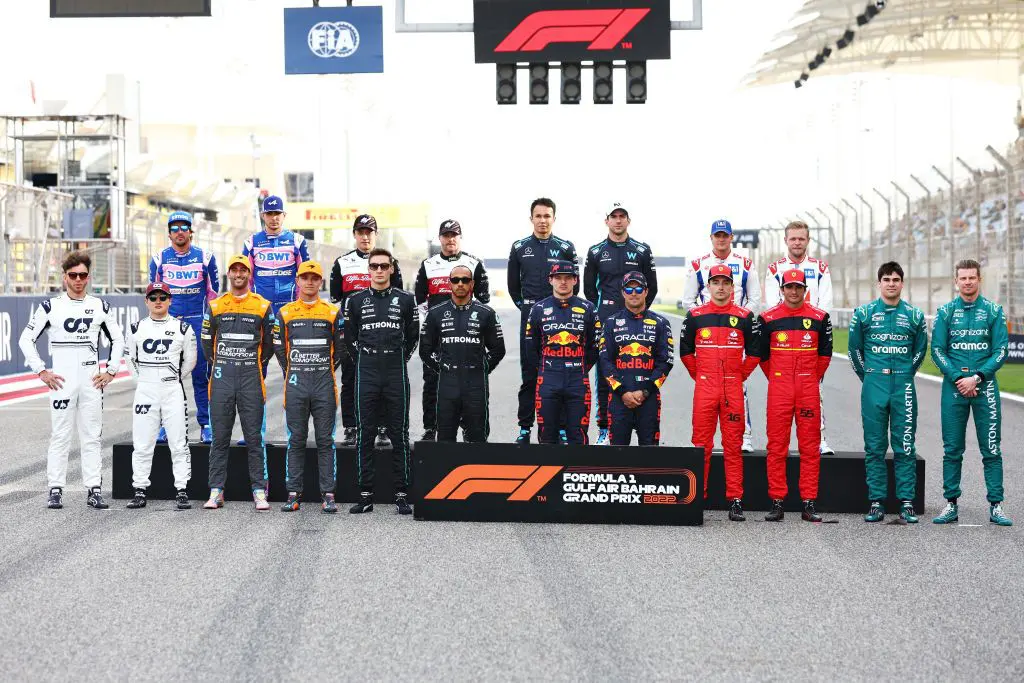
The million-dollar lightning-speed machines do not have autopilot features like in new Tesla cars. There should be a specially trained and skilled athlete with special licenses (aka FIA Super-license) to lead and drive those cars to the finish line. People are arguing that they are not real athletes because they only have to drive a car in circles a few times. That seems pretty obvious, but it is not the truth. In handling these mighty machines, the drivers are required to have lightning-speed reactions. And they must be eagle-focused because a lot of things can happen in a few fractions of a second.
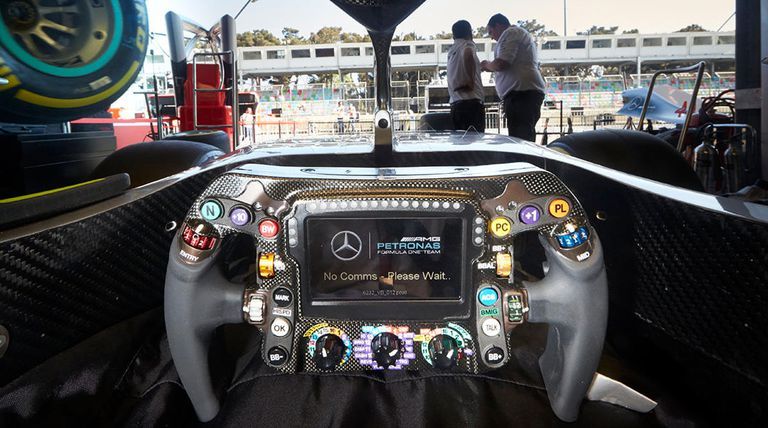
They need to change gears nearly 30-40 times for a single lap. And they have to tolerate all the G forces crushing their torsos while taking corners at high speeds. In a corner, they can experience up to 8G forces, to bear those crazy G forces they have to perform special exercises only to stay stable in those corners. They train their neck muscles and core muscles really hard to bear those G forces. And they can’t be overweight. An extra 100g can affect their speed and performance in a race. And they lose up to 5 kg of their body weight with fluids due to the heat of the cars and the environment. So they need to stay hydrated during the race time as well.
They have a specially designed drinking system of 1.5 l of fluids embedded into the driver’s cockpit in order to keep them hydrated. And when comparing to the amount they lose, that amount is clearly not enough. Racing in high-temperature circuits like Bahrain, Singapore, Saudi Arabia, and Abu Dhabi is really physically demanding to these athletes. So, considering those facts someone should never doubt whether these drivers are athletes or not.
- Teamwork
Even though a driver is competing alone in a long circuit, winning a race is not possible if the pit crew, strategists, engineers, and technicians work together with a prime determination to create a dominant race craft and make it ride through the straights and corners of a circuit with no flaws. A driver can’t win a race with only a good car. They need to have genius strategists who can turn a race with their ridiculous strategies and a sonic-like pit crew to change the tires and components of the car.
In conclusion, Formula 1 is a premier motorsport that has captivated audiences for decades with its high-speed races, cutting-edge technology, and world-class talent. From the iconic circuits of Silverstone and Monza to the futuristic streets of Singapore and Abu Dhabi, F1 takes fans on a global journey of excitement and drama. With its unique blend of speed, strategy, and skill, F1 offers something for everyone, whether you’re a seasoned fan or a newcomer to the sport.
But F1 is about more than just the on-track action and driving in a circle. It’s also a showcase for the latest in automotive technology and engineering, with teams constantly pushing the boundaries of what’s possible in the pursuit of speed. And with its global reach and massive fan base, F1 serves as a platform for sponsors and partners to showcase their products and services to a highly engaged and influential audience.
In short, Formula 1 is a thrilling and highly competitive sport that has earned its place as one of the premier events in the world of motorsports. Whether you’re following the action from the stands or on TV, make sure to tune in and experience the thrill of Formula 1 for yourself.
So, are you still questioning whether F1 is a real sport or just a car driving in a cIRcLe???
Image Courtesies
- Featured Image: https://bit.ly/3IMzlTR
- Content Image 1: https://bit.ly/3xPad8V
- Content Image 2: https://bit.ly/41eaQX7
- Content Image 3: https://bit.ly/3lXXQEM
- Content Image 4: https://bit.ly/3Zedtq1
- Content Image 5: https://bit.ly/3Sl2n0d
- Content Image 6: https://bit.ly/3xLwqEJ
- Content Image 7: https://bit.ly/3KwbNnN
- Content Image 8: https://bit.ly/3Ks5Ub7
- Content Image 9: https://bit.ly/3YWgMCn
- Content Image 10: https://bit.ly/3Ez7MLw
- Content Image 11: https://bit.ly/3KArhXI
- Content Image 12: https://bit.ly/3XUxu3K
- Content Image 13: https://bit.ly/3SmpB5W
- Content Image 14: https://bit.ly/3ImMB0d

